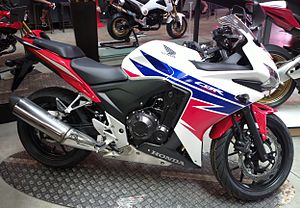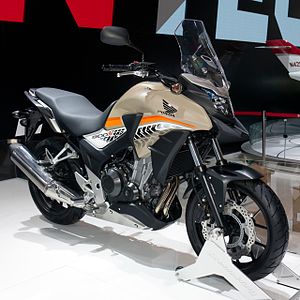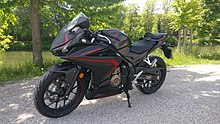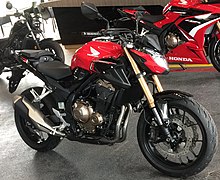
2013 CB500F
|
|
| Manufacturer | Honda |
|---|---|
| Production | 2013–present |
| Assembly | Samut Prakan, Thailand Manaus, Brazil |
| Predecessor | CBF500 2004-2008 |
| Class | Standard |
| Engine | 471 cc (28.7 cu in) liquid-cooled 4-stroke 8-valve DOHC Straight-twin engine |
| Bore / stroke | 67 mm × 66.8 mm (2.64 in × 2.63 in) |
| Compression ratio | 10.7:1 |
| Power | 47bhp |
| Transmission | 6-speed, wet multi-plate clutch, manual, chain drive |

2014 CBR500R
|
|
| Manufacturer | Honda |
|---|---|
| Production | 2013–Present |
| Assembly | Samut Prakan, Thailand Manaus, Brazil (2013-2018) |
| Class | Sport bike |

2016 CB500X
|
|
| Manufacturer | Honda |
|---|---|
| Production | 2013–Present |
| Assembly | Samut Prakan, Thailand Manaus, Brazil |
| Class | Adventure |
The Honda 500 twins are a series of straight-twin motorcycles made by Honda since 2013.
- CB500F standard/naked bike
- CB500X adventure touring bike
- CBR500R sport bike
- CMX500 Rebel bobber
These models are sold in Japan with smaller capacity 399 cc engines: CB400F (2013–2016), CB400X, and CBR400R.[1] Their introduction coincided with new European licensing regulations establishing a mid-range class of motorcycles of limited power.[2] The new 500 twins are similar to the earlier CB500 parallel-twins discontinued in 2003, but all-new from the ground up. They are made in Thailand, where Honda had previously made only smaller displacement motorcycles.[3]
All models use the same 471 cc (28.7 cu in) 180° crank straight-twin engine with capacity and power below the A2 European driving licence limit.[4] They share the same six-speed gearbox and the majority of cycle parts. The CB500X has a larger fuel tank and longer front suspension travel making it taller, and with more ground clearance.
On its release, the CBR500R was the one-design model the European Junior Cup in 2013 and 2014. Since 2014, Honda has partnered with local organisers to promote national CBR500R Cup events in Brazil and France; raced over various circuits, the competitions are open to amateurs from 13-years upwards.[5][6][7]
Model history

The three models were announced on the eve of the November 2012 EICMA show in Milan.
2013
April: CB500F, CBR500R released; July: CB500X released
2016
EURO 4 compliance with smaller exhaust,[8] LED headlamp, preload adjustable front suspension, smaller side covers, larger fuel tank on CB500F and CBR500R, Fireblade style fairing on the CBR500R
2019
Revised exhaust system, anti-rebound clutch, full LED lighting, revised rear shocks, new LCD instrumentation with additional features, 19" front wheel on the ruggedized CB500X,[9] dual-channel ABS standard on all models in most markets, although for 2017 USA models, it remained an option.[10][11]

2022
Inverted Showa Separate Function Fork - Big Piston (SFF-BP) forks, dual 296mm disk with radial calipers up front, updated triple tree clamps, new fuel injection settings that further increase torque feel and overall character, other changes include a lighter swingarm, lighter radiator, revised shock settings, redesigned and lighter front wheel, more powerful LEDs. The US Market only received the Pearl Organic Green colorway for 2022. [12][13]
The CB500X was released at a price of ฿224,900 (US$7,032.52) in Thailand.[14] In Germany, the CB500X was released at €7,099 (US$8,395.99).[15]
Reactions
Since its launch, the range received many favourable reviews; some preferring the taller X model while the sporty R model was one of Honda's top selling bikes in Canada during 2015 and best selling sports bike in Australia.[16][17][18] Many commentators, especially in off-road and long distance touring, argued the need for such middleweight bikes.[19][20] Perhaps as a consequence, in 2015, RallyRaid, a British after-market specialist, created upgrade kits for the R & F machines and a full adventure conversion kit for the X model.[21][20]
Multiple small improvements in the 2019 range impressed commentators with MCN describing the CB500X as an exceptional machine.[22][23]
Specifications
All specifications are manufacturer claimed unless otherwise specified. The motorcycle model designation is printed on a sticker under the seat.
| Model | CB500F[24] | CBR500R[25] | CB500X[26][27] |
|---|---|---|---|
| Type | Naked | Sport | Adventure |
| Engine | Four stroke, parallel twin, DOHC, 8 valves, liquid-cooled | ||
| Displacement | 471 cc (28.7 cu in) | ||
| Bore x stroke | 67.0 mm × 66.8 mm (2.64 in × 2.63 in) | ||
| Compression ratio | 10.7 : 1 | ||
| Fuel delivery | Honda PGM-FI via 34 mm (1.3 in) throttle bodies | ||
| Ignition | Fully transistorized with ignition advance | ||
| Maximum power | 35 kW (47 hp) at 8,500 rpm | ||
| Maximum torque | 43 N⋅m (32 lbf⋅ft) at 7,000 rpm | ||
| Transmission | 6-speed sequential, constant mesh | ||
| Clutch | Wet, multi-plate, coil spring | ||
| Final drive | 520 o-ring chain, 112 links | ||
| Frame | Tubular steel, diamond, stressed engine | ||
| Rake | 25.5° | 26.5° (2013–2018) 27.5° (2019-present) |
|
| Trail | 102 mm (4.0 in) | 108 mm (4.3 in) | |
| Turning radius | 2,700 mm (110 in) | 2,800 mm (110 in) (2013–2018) 2,400 mm (94 in) (2019-present) |
|
| Front wheel | 17M/C × MT3.50 cast aluminium 19 X MT2.5 CB500x (2019-present) |
||
| Rear wheel | 17M/C × MT4.50 cast aluminium | ||
| Front tyre | 120/70 ZR17 58W | 120/70 ZR17 55W (2013–2018) 110/80 R19 59H (2019-present) |
|
| Rear tyre | 160/60 ZR17 69W | 160/60 ZR17 69W (2013–2018) 160/60 R17 69H (2019-present) |
|
| Front brake | Single 320 mm (13 in) wave disc, 2 piston caliper, combined ABS | ||
| Rear brake | Single 240 mm (9.4 in) wave disc, 1 piston caliper, combined ABS | ||
| Front suspension | Conventional telescopic, 41mm (2013–2015) Conventional telescopic, 41mm, preload adjustable (2016–present) |
||
| Rear suspension | Prolink single shock, 9-stage preload adjustable; steel square pipe double-sided swingarm |
||
| Front suspension travel | 122 mm (4.8 in) | 140 mm (5.5 in) | |
| Rear suspension travel | 120 mm (4.7 in) | 105 mm (4.1 in) | |
| Wheelbase | 1,410 mm (56 in) | 1,420 mm (56 in) (2013-2018) 1,445 mm (56.9 in) (2019-present) |
|
| Overall length | 2,080 mm (82 in) | 2,095 mm (82.5 in) (2013-2018) 2,155 mm (84.8 in) (2019-present) |
|
| Overall width | 780 mm (31 in) (2013-2015) 790 mm (31 in) (2016-present) |
740 mm (29 in) (2013-2015) 750 mm (30 in) (2016-2018) 755 mm (29.7 in) (2019-present) |
830 mm (33 in) (2013-2018) 825 mm (32.5 in) (2019-present) |
| Overall height | 1,060 mm (42 in) | 1,145 mm (45.1 in) | Windscreen low: 1,260 mm (50 in) (2013-2015) 1,360 mm (54 in) (2016-2018) 1,410 mm (56 in) (2019-present) Windscreen high: 1,290 mm (51 in) (2013-2015) 1,390 mm (55 in) (2016-2018) 1,445 mm (56.9 in) (2019-present) |
| Seat height | 785 mm (30.9 in) | 810 mm (32 in) (2013-2018) 830 mm (33 in) (2019-present) |
|
| Ground clearance | 155 mm (6.1 in) (2013-2015) 160 mm (6.3 in) (2016-2018) 145 mm (5.7 in) (2019-present) |
140 mm (5.5 in) (2013-2018) 130 mm (5.1 in) (2019-present) |
170 mm (6.7 in) (2013-2018) 180 mm (7.1 in) (2019-present) |
| Fuel tank capacity | 15.5 L (3.4 imp gal; 4.1 US gal) (2013-2015) 16.7 L (3.7 imp gal; 4.4 US gal) (2016-2018) 17.1 L (3.8 imp gal; 4.5 US gal) (2019-present) |
17.3 L (3.8 imp gal; 4.6 US gal) (2013-2018) 17.5 L (3.8 imp gal; 4.6 US gal) (2019-present) |
|
| Engine oil | 3.2 L (0.70 imp gal; 0.85 US gal) | ||
| Coolant | 1.4 L (0.31 imp gal; 0.37 US gal) | ||
| Wet weight | 190 kg (419 lb) (2013-2015) 188 kg (414 lb) (2016-2018) 187 kg (412 lb) (2019-present) +2 kg (4.4 lb) ABS +1 kg (2.2 lb) California |
193 kg (425 lb) (2013-2015) 192 kg (423 lb) (2016-2018) 190 kg (419 lb) (2019-present) +2 kg (4.4 lb) ABS +1 kg (2.2 lb) California |
192 kg (423 lb) (2013-2018) 195 kg (430 lb) (2019-present) +2 kg (4.4 lb) ABS +1 kg (2.2 lb) California |
| Maximum weight capacity | 168 kg (370 lb) | 185 kg (408 lb) | |
| Fuel consumption | 28.4 km/L (80 mpg‑imp; 67 mpg‑US) (2013-2015) 29.4 km/L (83 mpg‑imp; 69 mpg‑US) (2016-2018) 28.6 km/L (81 mpg‑imp; 67 mpg‑US) (2019-present) |
28.4 km/L (80 mpg‑imp; 67 mpg‑US) (2013-2015) 29.4 km/L (83 mpg‑imp; 69 mpg‑US) (2016-2018) 27.8 km/L (79 mpg‑imp; 65 mpg‑US) (2019-present) |
|
References
- ^ "2020 Honda CBR400R Unveiled in Japan".
- ^ Velasco, Maria Teresa (24 October 2012). "European driving license 2013 - changes in motorbikes regulations". Velascolawyers.com. Retrieved 3 April 2019.
- ^ "Honda CB500F, CB500X and CBR500R review". Telegraph.co.uk. 24 July 2013. Retrieved 3 April 2019.
- ^ VisordownThu, 31 Oct 2013. "The A2 licence: What you can and can't restrict". Visordown.com. Retrieved 3 April 2019.
- ^ "Copa Honda CBR 500R – SuperBike". Superbike.com.br. Retrieved 3 April 2019.
- ^ "La Honda CBR 500 Cup repart pour une troisième saison - Moto Journal". Archived from the original on 2017-07-31. Retrieved 2017-07-31.
- ^ [1][dead link]
- ^ "2016 HONDA CB500F". hondanews.eu.
- ^ "Honda brings new energy to middleweight line-up with 5 product reveals at 2018 EICMA show". Hondanews.eu. Retrieved 3 April 2019.
- ^ "General Error". Powersports.honda.com. Retrieved 3 April 2019.
- ^ "Honda CBR500R vs. Kawasaki Ninja 300 - Batting 500". Motorcyclistonlnie.com. Retrieved 3 April 2019.
- ^ "Honda CB500X Receives Performance Updates for 2022". advpulse.com. 3 September 2021. Retrieved 3 September 2021.
- ^ "HONDA CB500X (2022 - on) Review". motorcyclenews.com. Retrieved 20 October 2021.
- ^ "A league of their own". Bangkok Post.
- ^ Horvath, Der (September 23, 2021). "Honda CB500X 2022 Test - Erfahrungen mit der A2 Reiseenduro". www.1000ps.at.
- ^ "HONDA CB500X (2013-18) Review". Motorcycle News. 8 January 2014. Retrieved 3 April 2019.
- ^ "Honda Reclaims Top Spot in the Canadian Market". Asphaltandrubber.com. 20 January 2015. Retrieved 3 April 2019.
- ^ Hedge, Trevor (7 April 2016). "Motorcycle sales, all-terrain vehicle (ATV) and scooter market for the first quarter of 2016 was 1.6 per cent higher than the corresponding period in 2015". Mcnews.com.au. Retrieved 3 April 2019.
- ^ "Why the New CB500X Adventure Makes a Great Bike for the TAT". Advpulse.com. 13 November 2015. Retrieved 3 April 2019.
- ^ a b "Honda CB500X Rally Raid 5000-mile review". Adventure-motorcycling.com. 27 December 2015. Retrieved 3 April 2019.
- ^ "A CB500 to take on the world". Overlandmag.com. 8 May 2015. Retrieved 3 April 2019.
- ^ "HONDA CB500F (2019-on) Review". Motorcycle News. 14 January 2019. Retrieved 24 October 2019.
- ^ "HONDA CB500X (2019-on) Review". Motorcycle News. 14 January 2019. Retrieved 24 October 2019.
- ^ "Specifications – CB500F – Street – Range – Motorcycles – Honda". Honda.co.uk. Retrieved 3 April 2019.
- ^ "Specifications – CBR500R – Super Sport – Range – Motorcycles – Honda". Honda.co.uk. Retrieved 3 April 2019.
- ^ "Specifications – CB500X – Adventure – Range – Motorcycles – Honda". Honda.co.uk. Retrieved 3 April 2019.
- ^
Owner's Manual CB500XA. 2015. p. 115.
{{cite book}}:|website=ignored (help)